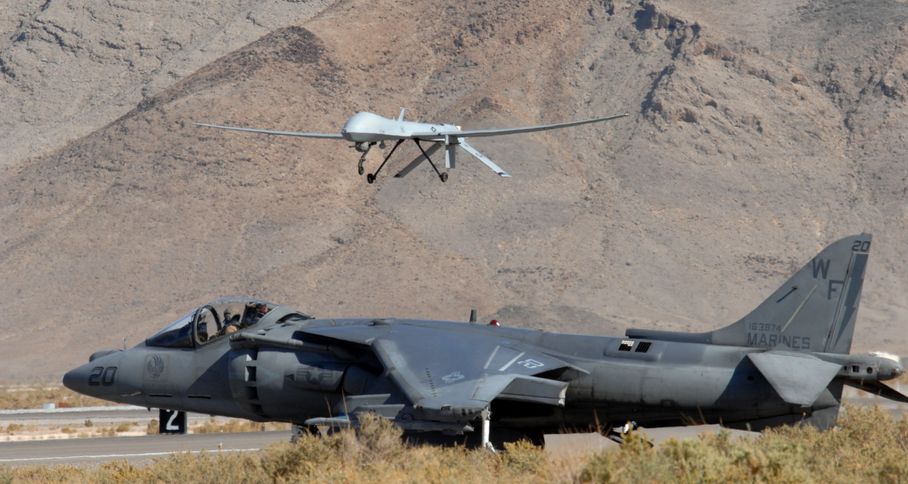
Rivalry between the Army and Air Force over Predator drones may have cost the Pentagon over $500 million in wasteful spending, according to a report released under the Freedom of Information Act.
The report, which the Pentagon’s Inspector General completed in 2010, is not available on the Defense Department’s public website, which instructs people to request it through the Freedom of Information Act. The Pentagon released a copy of the report to The Intercept this week, nearly five years after it was originally requested.
The report blasts both the Army and the Air Force for spending $115 million in 2008 and 2009 on research efforts that were supposed to help combine their Predator programs, in other words, to buy the same drone. Those efforts were “ineffective,” the report said, depriving the Pentagon of an estimated $400 million in savings that would have resulted.
The inability of military services to agree on a single aircraft or weapon is nothing new, but the report addresses one of the more high-profile conflicts between the Army and the Air Force in recent years. In 2008, then Defense Secretary Robert Gates rebuked the Air Force, saying it was like “pulling teeth” to get the service to contribute more drones to Iraq and Afghanistan.
While the Air Force was being criticized for not sending enough drones, the Army, in the meantime, was buying its own Predators under a program known as Sky Warrior. The Army’s encroachment on traditional Air Force territory set off a bitter turf war between the two services; Army commanders griped that the Air Force didn’t support ground troops, and theAir Force claimed the Army didn’t understand how to operate drones effectively.
In a dispute that played out publicly, the Air Force Association even called the Army drone program “a house of cards.”
Among other differences between the services, the Army deploys its drone pilots close to ground operations, while the Air Force pilots its drones from remote bases, including in the United States. The aircraft themselves are also different; for example, the Air Force’s Predator uses jet fuel, while the Army’s can run on heavy fuel.
In May 2008, Pentagon officials ordered the two services to unify their efforts to save money, since they were effectively buying the same type of drone from General Atomics Aeronautical Systems. The services never did that; the Air Force responded by ending its purchase of the Predator altogether and buying a new, larger variant of the Predator called Reaper.
Sen. Chuck Grassley criticized the Inspector General for taking nearly two years to complete the audit, and then doing little to enforce its recommendations. “While the audit was in progress, DoD pulled the rug out from under the auditors,” Grassley said in a floor statement in 2011. “A new directive was issued, stating that the two programs did not have to be combined.”
When the auditors recommended “administrative action” against personnel who failed to follow the original guidance, the Pentagon, Grassley said, “tossed the auditors a bone,” by studying “lessons learned” from the program.
While many of the Defense Department’s Inspector General reports are available to the public, this Predator report was marked “official use only.” A spokesperson for the Inspector General was not able to comment by publication on why the unclassified report was not released previously.
As to the issues raised in the report, Pentagon spokesperson Maureen Schumann pointed to the Defense Department’s response included in the report, which notes that the Air Force met the military’s demand for increasing surveillance capabilities by “zeroing procurement of Predator and maximizing procurement of Reaper aircraft” in its budget plans.
Whether combining the programs really would have ultimately produced savings is unclear. “I have no doubt, however, that they wasted lots of money on these programs,” said Chuck Spinney, a former military analyst famous for criticizing the cost of the Pentagon’s weapons. “But the claim that you could save money by combining them flies in the face of history and the political dynamics of gold plating.”
According to Spinney, even when the military services have run programs jointly, such as with the F-35 Joint Strike Fighter, they still end up requesting so many different modifications that it is questionable whether any money is saved in the end.
The real question may be whether both the Air Force and Army really needed to operate their own Predator drones.
Military analyst William Arkin argued the Army didn’t have a good justification for buying its own Predators, it just wanted them. “The Army in the end just wanted to be more like the Air Force, more capable of targeted killing,” Arkin told The Intercept.
In his new book, Unmanned: Droned, Data and the Illusion of Perfect Warfare,Arkin also argues that there never was a real scarcity of drones in Iraq or Afghanistan. “Even though the flock migrating to the battlefield was mind boggling in numbers and diversity, that picture of want — not control or numbers — drove the crisis,” he wrote.
https://firstlook.org/theintercept/2015/08/12/pentagons-half-billion-dollar-drone-boondoggle/